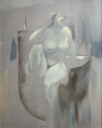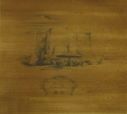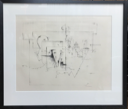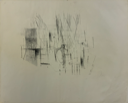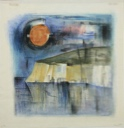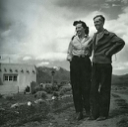American Taos Moderns
American, (1887–1958)
Thomas Benrimo was born in San Francisco in 1887. Although his formal education ended with the fourth grade, he had tremendous intellectual capacity and independently studied anatomy, history, archaeology, physics, engineering, aerodynamics, music, literature and philosophy. Drawing came naturally to him and he sketched from a very early age. The Benrimo family lost their home and all of their possessions in the historic earthquake and fire of 1906 and moved to New York City to start a new life. The train trip to New York offered Benrimo his first view of the Southwest, and he was deeply impressed by the stark form and beauty of the American desert.
During his first years in New York he designed sets and costumes for numerous theatrical companies, including the New York Drama Society. In 1913 he visited the Armory Show, where for the first time he realized that the means of expression in art could have far greater importance than the subject represented. Inspired by the show he painted initially in an energetic style derived from Cubism. In these early canvases, there is a sense of violence and chaos, of dispersed and unrelated forms being pulled together into an order. One thinks of the artist's violent memories of disaster which displaced him and his family. Over the next twenty years, however, Benrimo devoted his time largely to commercial illustrations, and in 1935 took a position teaching commerical design at the Pratt Institute. But he was eager to leave New York and begin a new life as an independent painter, and in 1939 he ended his highly successful commercial career, married, and moved to Taos. It was about this time that he began experimenting with Surrealism. Thus, four years after Andre Breton issued his Surrealist Manifesto, Tom Benrimo became the first Surrealist artist in New Mexico.
Artists came to New Mexico for several reasons. Benrimo wanted to remove himself from the demands of metropolitan artistic pressures. He wanted to achieve an individual evolution that is almost impossible to do in major art centers such as New York City. Isolating himself from the avant-garde allowed him a quite individual development within the major movements known to modern art. He questioned and extended movements that had their impetus in Europe. In his works, he examined physical, philosophical and psychological questions extrapolated from international art historical awareness. Benrimo was one of the few twentieth-century artists who succeeded in translating a personal mystic vision of the American Southwest into Surrealist imagery. He developed symbolism that enabled him to paint the dreams and fantasies that for him expressed the essence of the life and the land of New Mexico. His Surrealist paintings explore not only the power and the mystery of the land - the vast, alien desert and the towering barren mountains - but also the relationship between the land and its inhabitants.
During his first ten years in Taos, Benrimo experimented with Cubist techniques and designs and completed a series of Surrealist paintings of the area. Initially he reacted to the potent force of New Mexico's unlimited space in a Daliesque manner. Clearly delineated but incongruous forms were brought together to create fantastic imagery which incorporated details drawn from his past life in the theatre and his later life in sight of the Taos mountains. These paintings were undoubtedly enigmatic to the residents of New Mexico when first seen, for no other painter in the region had used this style of expression - often a play of associations incorporating New Mexican motifs in fragmentary and dislocated form. In Benrimo's paintings the desert is a lifeless wasteland. Yet superimposed on this world of rock, sand, and sky is a human melodrama enacted by members of three cultures - the Pueblo Indians, the Spanish-Americans (especially the Penitentes), and the Anglos. The men and women are isolated in a hostile environment, and the structures they have built - an adobe house, an artist's studio - are suspended in limbo.
Benrimo's art never became repetitive, for by 1950 he had lost interest in three-dimensional form and anything even bordering on illustration, and began to experiment with nonobjective painting. During the last decade of his career, he devoted his full energy to abstract art. Benrimo intensified his search for a more personal style, and by the time of his death in 1958 had achieved a forceful form of expression. In these paintings, subtle geometric elements retain a suggestion of the stage as he used an interplay of transparent planes, played upon a vaguely-seen theatrical backdrop. Considered one of New Mexico's major contemporary artists, Benrimo has been honored with numerous awards and one-man shows. "What might be called my philosophy of art," he wrote, "is extremely simple and can be expressed by quotation from Charles Norman's William Shakespeare: 'There are no movements, only artists.'"
Source: Owings-Dewey Fine Art, 76 East San Francisco Street, Santa Fe, New Mexico 87501.
Cityscape 1990.033
Eve 1984.015
Female Nude 1981.009
Fiesta, Ranchos de Taos 1984.057
Figures in Landscape 1982.015
Forms, 1955 1990.032
Harbor 1984.040
Harbor and Mountain 1992.015
Imaginary Landscape 1987.022
King Lear and Dondrao 2001.007
Reclining Nude 1992.026
The Windmill 1981.008
Untitled (buildings with dark roofs) 1981.010
Windblown 1983.011



